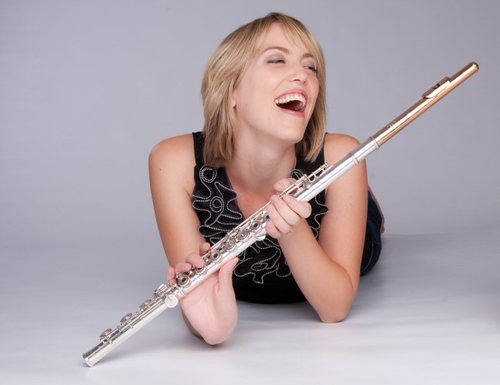Flutist Keith Underwood was recently a guest artist at The Pennsylvania State University campus in University Park, PA. While on campus, he gave an hour-long breathing seminar and a two-hour masterclass. My article is a summary of what he shared with my studio this past month.
I asked Prof. Underwood about his creative teaching strategies. He said he was lucky to have great teachers that were willing to explain how they accomplished what they did. I can tell that he takes joy in discovering new ways to approach the flute. He also learns from all musicians including singers, brass players and pianists.
He spoke about four topics that are fundamental to all flute playing:
- Breathing
- Articulation
- Tone
- Posture
BREATHING:
- Finger Breath. A wonderful tool to work on the basic inhale. Take the knuckle of your first finger of either hand and place it in the middle of your lips. Form suction around the lips and inhale. There should be a rushing sound that is created by your suction around your finger. Once you have mastered the finger breath try playing off that air. It will open up your sound and you will have a larger volume of air.
- Breathing Bag: You can purchase your very own breathing bag at ModoMed.com (3 Liter). It is very affordable and incredibly helpful tool for practicing breathing, as well as phrasing and articulation. Things to remember when using the breathing bag: make sure your lips surround the tube’s opening, which results in a more open throat. Before doing any exercise on the bag do one set of the inhale/exhale on the bag before doing your exercise. The breathing bag is a great way for the body to relax while practicing breathing.
- There is an up and down component to breathing. If you restrict this motion you will not get as much air as you think.
- When you are nervous you tend to take many short breaths. This makes your body shut down.
- More CO2 is better than O2 if you need to calm down before a performance. This is one reason why the breathing bag has such great results in your playing.
- Don’t shy away from the benefits of a good nose breath. Feel the openness from a nose breath.
- Your breath should cue the beginning of your piece, not a large movement from your flute.
- Rhythmic Breathing. Make sure your breath reflects the pulse and style of the piece in which you are playing. Practice this on the breathing bag before you do it on the flute.
- Breath control is like a controlled sigh.
- Ending a note with a “stomach breath” makes the release of the note too abruptly. Instead think about lifting off the flute like a violin bow when breathing.
- Breath Builder: Another breathing tool invented by a bassoon player. You can find these at Guitar Center (just google Breath Builder).
- Cat breath: Taking a spin on the yoga pose. Breathing into the back and letting it expand more in the back than in the front.
ARTICULATION:
- The “F” in flute creates a sound when you say the word. This sound is called a fricative. Use this sound when tonguing, more of a “Tf”, especially in the high register.
- Tonguing should have an up and down feel. The second syllable in your double tonguing should have an up feeling. To demonstrate this, move one of your fingers up and down. Now do this while you are articulating a note. Does it change the way you think about articulating?
- Articulations are in front of mouth and registers and dynamics are in the back.
- Keep the base of your tongue in the back of your mouth. The front of your tongue does the articulation.
- Tongue on top of the tongue, not at the tip. You should feel your canines when you tongue softly.
- “Duh” is a great word to use for a more relaxed and responsive articulation.
TONE:
- Whispered “Ahs”. This is an Alexander Technique that Professor Underwood has adapted for tone development. Think of a stage whisper. Then say it with the word “Ah”, continuously blowing through it. Ideally this throat position is what you will play with. If not, work on getting the air to the back of your head. After you have mastered the position, try whispering at different pitches without moving your jaw.
- Move your chin muscles up towards the top lip for more focus and control in the sound.
- When you add vibrato you do not have to blow harder.
- Sound is made in the back of the head, behind the nose. Send air to the back of the mouth and aim it up and down.
- Low Note: Behind neck. High Note: Behind nose. Pretend you have a Casio keyboard that you play up and down.
- Pharynx: Know your anatomy. This is where the sound is created. There are three regions…. “Google” an image and you will be surprised!
- Shape the air with your lips. Don’t control the air with your lips.
- Vowel placements are in the back of your mouth. Consonants in front of your mouth.
- Forming the sound “Pha” is a great way to find proper lower lip placement.
- Embouchure is inside the mouth.
POSTURE:
Prof. Underwood believes all musicians can benefit from Alexander Technique. Although not a trained practician, he has worked with many professional Alexander Technique teachers. Here are the references to Alexander Technique that he made throughout the classes:
- The head leads and the body follows
- Look down your nose at the music
- Keep your eyes active and do not move the head to look down at the music
- Find your length
- Bring the instrument to you and adjust the placement with your upper arms
- Get taller as you descend in range
- Put the weight on the middle of your feet
- Whispered “Ah”
- Lift the flute from the inner part of your arms
EXTRA RESOURCES:
Prof. Underwood gave us many wonderful YouTube links to look into that were great references that reinforced his ideas. Here are a few of my favorites.
- Julius Baker performing Shostakovich 5 with Bernstein. See how he looks as if he is rising out of his chair in the solo when he is descending, about 5 minutes in. https://www.youtube.com/watch?v=0FF4HyB77hQ
- Glen Gould finger tapping: https://www.youtube.com/watch?v=MkI-aKqQ1kI
- Denis Bouriakov Note Bending: https://www.youtube.com/watch?v=5u3VYim6OcY
- Angela Caine: Voice Gym: http://www.voicegym.co.uk
If you find this information helpful, Prof. Underwood teaches privately in NYC and is also on faculty at New York University and Mannes School of Music. He keeps a steady teaching schedule. See more information about Keith and his teaching schedule at http://keithflute.com/Keithflute/keith_underwood.html.
About Naomi Seidman
 Naomi Seidman joined The Pennsylvania State University School of Music faculty in 2012. An accomplished solo performer, she has won the Mid-South Flute Competition and the Frank Bowen Young Artist Competition, and was first runner-up in the Myrna Brown Young Artist Competition. She was also a semi-finalist in the Beijing Nicolet International Flute Competition. She has performed as a soloist with the Pennsylvania Centre Orchestra, Santa Fe Symphony, Kingsville Symphony, and Ballet Austin. She has also been an invited performer, judge, and presenter at National Flute Association (NFA) conventions and is a member of the NFA Cultural Outreach Committee.
Naomi Seidman joined The Pennsylvania State University School of Music faculty in 2012. An accomplished solo performer, she has won the Mid-South Flute Competition and the Frank Bowen Young Artist Competition, and was first runner-up in the Myrna Brown Young Artist Competition. She was also a semi-finalist in the Beijing Nicolet International Flute Competition. She has performed as a soloist with the Pennsylvania Centre Orchestra, Santa Fe Symphony, Kingsville Symphony, and Ballet Austin. She has also been an invited performer, judge, and presenter at National Flute Association (NFA) conventions and is a member of the NFA Cultural Outreach Committee.
As a chamber musician, Naomi is a member of the Pennsylvania Quintet, a woodwind quintet comprised of Penn State faculty members. She also performs regularly with her husband, cellist Jonathan Dexter, as the JANO Duo. Involved in several exciting commissioning projects for both groups, Naomi is dedicated to expanding repertoire for this combination of musicians. She has also collaborated with the Vienna Piano Trio and the Walden Chamber Players. She has participated in numerous festivals, including Yellow Barn, Bowdoin Summer Music Festival, Eastern Music Festival, Sewanee Summer Music Festival, Colorado College Summer Music Festival, Austin Classical Guitar Society, and the Austin Chamber Music Center.
Naomi is the recipient of numerous grants and awards, including the National Endowment for the Arts “Fast Track America Grant” and the Penn State College of Arts and Architecture “Award for Excellence in Advising and Mentoring.”
A dedicated educator, Naomi has presented masterclasses at the University of Texas at Austin, Texas State University, Texas A&M University-Corpus Christi, Ohio State University, Capital University, Ball State University, Oklahoma State University, Texas A&M University-College Station, University of Texas at Brownsville, and Southeastern Oklahoma State University.
In 2012, she created the Penn State Flute Day, an annual event where area flutists of all ages gather to attend masterclasses and recitals given by a renowned flutists. The symposium’s guest artists have included Jill Felber, Bart Feller, and Bonita Boyd.
Naomi received her bachelor’s degree from the University of California at Santa Barbara, the Master of Music degree from Yale University, and her doctoral degree the University of Texas at Austin.
She plays on a handmade Powell flute.
Points of Note – Underwood Workshop – .pdf


Thanks for the great notes from the class Professor Seideman. Always great teaching and ideas from Keith Underwood; and he always is coming up with new concepts, techniques and ways to describe things.
Hi Jerry! I agree about Keith Underwood. I ran across this gym yesterday: https://www.lessonface.com/apply/keith-underwood-flute-seminar
So many online resources. Thanks for reading!